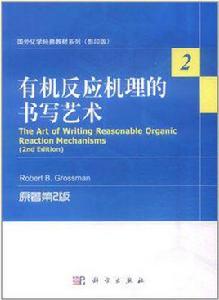內容介紹
《有機反應機理的書寫藝術(原著第2版)》內容簡介:每一個滿懷抱負的有機化學家都嘗試寫出合理的有機反應機理,然而市面上的有關機理正確書寫的書籍卻寥寥無幾。《有機反應機理的書寫藝術(原著第2版)》將幫助學生和科研人員提高這一重要技能。《有機反應機理的書寫藝術(原著第2版)》的突出特點體現在:正確的書寫形式,“常見錯誤提示”,配以大量的難度適宜的問題。其另一個特色是包含過渡金屬參與或催化的反應章節。相對新的課題,例如,烯烴複分解反應、芳香環化反應等在《有機反應機理的書寫藝術(原著第2版)》中均有所涉及。
全新修訂的第2版精彩呈現:更新的反應機理,芳香性的討論,酸性,立體化學的拓展,重新組織了自由基反應和金屬參與或催化的反應等內容,增加了新的問題。
目錄
Preface to the Student
Preface to the Instructor
1 The Basics
1.1 Structure and Stability of Organic Compounds
1.1.1 Conventions of Drawing Structures;Grossman's Rule
1.1.2 Lewis Structures;Resonance Structures
1.1.3 Molecular Shape;Hybridization
1.1.4 Aromaticity
1.2 Brønsted Acidity and Basicity
1.2.1 pKValues
1.2.2 Tautomerism
1.3 Kinetics and Thermodynamics
1.4 Getting Started in Drawing a Mechanism
1.5 Classes of Overall Transformations
1.6 Classes of Mechanisms
1.6.1 Polar Mechanisms
1.6.2 Free-Radical Mechanisms
1.6.3 Pericyclic Mechanisms
1.6.4 Transition-Metal-Catalyzed and-Mediated Mechanisms
1.7 Summary
Problems
2 Polar Reactions under Basic Conditions
2.1 Substitution and Elimination at C(Sp)-XσBonds,Part 1
2.1.1 Substitution by the S2 Mechanism
2.1.2 β-Elimination by the E2 and Elcb Mechanisms
2.1.3 Predicting Substitution vs.Elimination
2.2 Addition of Nucleophiles to ElectrophilicπBonds
2.2.1 Addition to Carbonyl Compounds
2.2.2 Conjugate Addition;The Michael Reaction
2.3 Substitution at C(Sp)-XσBonds
2.3.1 Substitution at Carbonyl C
2.3.2 Substitution at Alkenyl and Aryl C
2.3.3 Metal Insertion;Halogen-Metal Exchange
2.4 Substitution and Elimination at C(Sp)-XσBonds,Part Ⅱ
2.4.1 Substitution by the S1 Mechanism
2.4.2 Substitution by the Elimination-Addition Mechanism
2.4.3 Substitution by the One-Electron Transfer Mechanism
2.4.4 Metal Insertion;Halogen-Metal Exchange
2.4.5 α-Elimination;Generation and Reactions of Carbenes
2.5 Base-Promoted Rearrangements
2.5.1 Migration from C to C
2.5.2 Migration from C to 0 or N
2.5.3 Migration from B to C or 0
2.6 Two Multistep Reactions
2.6.1 The Swem Oxidation
2.6.2 The Mitsunobu Reaction
2.7 Summary
Problems
3 Polar Reactions Under Acidic Conditions
3.1 Carbocations
3.1.1 Carbocation Stability
3.1.2 Carbocation Generation;The Role of Protonation
3.1.3 Typical Reactions of Carbocations;Rearrangements
3.2 Substitution and β-Elimìnation Reactions at C(Sp)-X
3.2.1 Substitution by the Sl and S2 Mechanisms
3.2.2 ?-Elimination by the El Mechanism
3.2.3 Predicting Substitution vs.Elimination
3.3 Electrophilic Addition to Nucleophilic C=C π Bonds
3.4 Substitution at NucleophiJic C=C π Bonds
3.4.1 Electrophilic Aromatic Substitution
3.4.2 Aromatic Substitution of Anilines via Diazonium Salts
3.4.3 Electrophilic Aliphatic Substitution
3.5 Nucleophilic Addition to and Substitution at Electrophilic π Bonds
3.5.1 Heteroatom Nucleophiles
3.5.2 Carbon Nucleophiles
3.6 Summary
Problems
4 Pericyclic Reactions
4.1 lntroduction
4.1.1 Classes of Pericyclic Reactions
4.1.2 Polyene MOs
4.2 Electrocyclic Reactions
4.2.1 Typical Reactions
4.2.2 Stereospeficity
4.2.3 Stereoselectivity
4.3 Cycloadditions
4.3.1 Typical Reactions
4.3.2 Regioselectivity
4.3.3 Stereospecificity
4.3.4 Stereoselectivity
4.4 Sigmatropic Rearrangements
4.4.1 Typical Reactions
4.4.2 Stereospecificity
4.4.3 Stereoselectivity
4.5 Ene Reactions
4.6 Summary
Problems
5 Free-Radical Reactions
5.1 Free Radicals
5.1.1 StabiIity
5.1.2 Generation from Closed-Shell Species
5.1.3 Typical Reactions
5.1.4 Chain vs.Nonchain Mechanisms
5.2 Chain Free-Raclical Reactions
5.2.1 Substitution Reactions
5.2.2 Addition and Fragmentation Reactions
5.3 Nonchain Free-Raclical Reactions
5.3.1 Photochemical Reactions
5.3.2 Reductions and Oxidations with Metals
5.3.3 Cycloaromatizations
5.4 MiscelIaneous Radical Reactions
5.4.1 1,2-Anionic Rearrangements;Lone-Pair Inversion
5.4.2 Triplet Carbenes and Nitrenes
5.5 Summary
Problems
6 Transition-Metal-Mediated and-Catalyzed Reactions
6.1 Introduction to the Chernistry of Transition Metals
6.1.1 Conventions of Drawing Structures
6.1.2 Counting Electrons
6.1.3 Typical Reactions
6.1.4 Stoichiometric vs.Catalytic Mechanisms
6.2 Addition Reactions
6.2.1 Late-Metal-Catalyzed Hydrogenation and Hydrometallation(Pd,Pt,Rh)
6.2.2 Hydroformylation(Co,Rh)
6.2.3 Hydrozirconation(Zr)
6.2.4 Alkene Polymerization(Ti,Zr,Sc,and others)
6.2.5 Cyclopropanation,Epoxidation,and Aziridination of Alkenes(Cu,Rh,Mn,Ti)
6.2.6 Dihydroxylation and Arninohydroxylation of Alkenes(Os)
6.2.7 Nucleophilic Addition to Alkenes and Alkynes(Hg,Pd)
6.2.8 Conjugate Addition Reactions(Cu)
6.2.9 Reductive Coupling Reactions(Ti,Zr)
6.2.10 Pauson-Khand Reaction(Co)
6.2.11 D?tz Reaction(Cr)
6.2.12 Metal-Catalyzed Cycloaddition and Cyclotrimerization(Co,Ni,Rh)
6.3 Substitution Reactions
6.3.1 Hydrogenolysis(Pd)
6.3.2 Carbonylation of A1kyl Halides(Pd,Rh)
6.3.3 Heck Reaction(Pd)
6.3.4 Coupling Reactions Between Nucleophiles and C(Sp)X:Kumada,Stille,Suzul?,Negishi,Buchwald-Hartwig,Sonogashira,and Ullmann Reactions(Ni,Pd,Cu)
6.3.5 Allylic Substitution(Pd)
6.3.6 Pd-Catalyzed Nucleophilic Substitution of Alkenes;Wacker Oxidation
6.3.7 Tebbe Reaction(Ti)
6.3.8 Propargyl Substitution in Co-Alkyne Complexes
6.4 Rearrangement Reactions
6.4.1 Alkene Isomerization(Rh)
6.4.2 Olefm and Alkyne Metathesis(Ru,W,Mo,Ti)
6.5 Elimination Reactions
6.5.1 Oxidation of Alcohols(Cr,Ru)
6.5.2 Decarbonylation of Aldehydes(Rh)
6.6 Summary
Problems
7 Mixed-Mechanism Problems
A Final Word
Index
專家評論
“這是一部優秀並完美表達的作品……作者……成功地將反應活性和選擇性的核,小觀點視為一個有機整體詳盡表述 簡潔的文風,精選的實例……每一章末對要點簡明的概括,使得讀者很容易鞏固學到的知識……這本書不失為一個小小的藝術品。”——Jens Hartung,Angewandte Chemie International Edition
“我使用該書教授學分課程已經三年時間了,學生們一致對本書的透徹敘述和書中試題的覆蓋面給予高度讚譽……正如本書的宗旨:教會學生準確寫出陌生的有機反應的機理。”——Amy Howell,Synthesis

